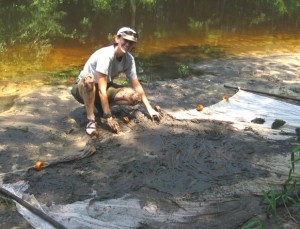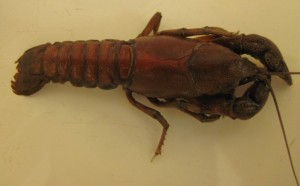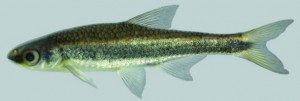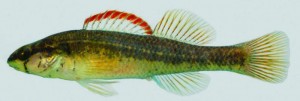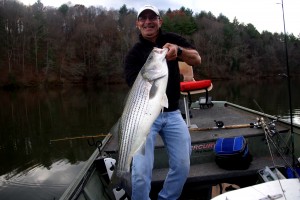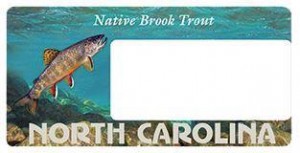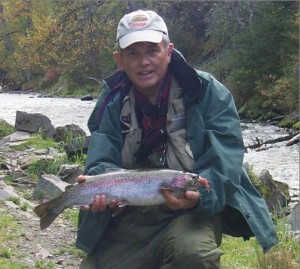Winter 2014 Newsletter
Quick Content Links
- President’s Message
- 2015 NCAFS Annual Meeting Reminder
- Call for Chapter Award Nominations
- Nominations Committee and Ballot
- Update from the North Carolina Division of Water Resources Wadeable Stream Fish Community Monitoring Program
- Biologists Hope to Restore Rare Fish in Pee Dee River
- Retired but Still Hard at Work!
- NC State University Student Fisheries Society Update
- Hydrilla in the Cape Fear River
- A Summary of the 2010 Reevaluation of Status Listings for Jeopardized Freshwater Fishes in North Carolina
- Native Brook Trout License Plate Offered to North Carolina Drivers
- Fred Harris Receives Prestigious Award
- Biologists Find Gill Lice in Brook Trout in Cullasaja River Tributaries
- Highlighted Meetings of Interest
- Valuable Links
President’s Message
I’d postulate that even the fish are tucked into a sheltered nook as 2014 slides to a close in a distinct form of damp grey. Realizing this is my last ‘President’s Message’ surprisingly reflects that shade more than I’d have imagined. However, after you entrusted me with the leadership of our Chapter, I have learned and enjoyed more than I ever guessed. The opportunity to step back and examine fisheries science and conservation in NC in the context of our mission statement and AFS, as well as in connection with students and other state and regional subunits, has given me an entirely new vantage point. This view somehow manages to be both so much broader, and so much more focused than the one from my office or the bow of my boat.
I believe this occurs because you have allowed me to integrate my years in the mud, counting fin rays, and attempting to write legibly with frozen fingers, into this experience of trying to maintain, coordinate, and streamline this dedicated group, which continues to produce excellent science towards a much larger common goal. We all know that no one person can reach our sorely needed habitat and community conservation goals alone. However, I’ve held tight for several decades to the truth that many small things, such as the projects we pour ourselves into, can accumulate into a big thing if the communication is there.
As our 2015 Annual Chapter Meeting approaches, one such opportunity to build on our already-strong foundation arises. November saw a phenomenal collection of oral and poster presentations at the recent Southeastern Fishes Council meeting in Asheville, NC. In addition, at the end of January, a subsample of our “school” will carry those efforts to Georgia for the 2015 Southern Division Spring Meeting.
Continuing in the spirit of communication, the Chapter will also see a slight shuffling, in that the existing Newsletter Committee, faithfully and excellently steered by Kevin Hining, will be expanded and renamed the Communications Committee, as permitted under our Procedures Manual. This will bring together our existing newsletter and listserv with the website operations, along with Jennifer Archambault, who has been doing a great job running our Chapter Facebook page on her own. We are also adding Kelsey Lincoln to the committee. Kelsey is a recent NC State University graduate, and currently serves as the District 5 Fisheries Biologist I with the NC Wildlife Resources Commission. We aim for a more cohesive presence, both online and among membership, as well as increased opportunities for your interaction and contributions, from students and professionals alike.
I had the opportunity, in October, to participate in the 2nd Annual AFS Leadership conference call, which gathered chapter and subunit leaders in a conversation with Parent Society staff. Common issues, such as chapter finances, membership management, as well as a wealth of both existing and new supportive services offered by AFS (who are also unveiling an updated website in phases with expanded resources and greater unit connectivity), were all on the table. The consistent and sincerely stated message from AFS was a strong focus on unit support, how to increase the utility and accessibility of Parent Society membership, and a drive to gather feedback, questions, and suggestions on what AFS can do for us.
As many of you know (I hope you’ve looked AT LEAST once by now!), I’ve been working closely with the AFS Webmaster, Sarah Gilbert Fox, while building the new NCAFS website. We continue to add new functionality and I cannot express enough how positive, supportive, and enjoyable the work with Sarah has been. The same is true for each AFS staff member that I’ve spoken with. While everyone is no doubt busy with holidays and wrapping up the year, I highly encourage, as do the staff themselves, contacting the appropriate members if you have thoughts or questions to share.
Thank you again for the honor and opportunity to serve as Chapter President. Although I will no longer be a member of EXCOM after 2016, I will remain your Webmaster, so please do not hesitate to contact me via email or our online contact form, as my “door” remains open to dialogue.
May the “fish” be with you –
Brena Jones
2015 NCAFS Annual Meeting Reminder
Please come and participate in the 2015 NCAFS Annual Meeting at the Marriot Courtyard Carolina Beach February 24th – 25th. You will enjoy two days of high quality technical presentations on a variety of North Carolina’s fisheries research, with an optional technical workshop Tuesday morning. Tuesday evening we’ll have the annual student raffle along with our annual social. All rooms are ocean front, and we are getting a great rate of $69.50 per night. Use this booking link to reserve your room, or mention NCAFS when you call 1-800-321-2211 to book your reservation.
Second Call for Abstracts
Student and professional members are invited to submit abstracts for oral presentation at the Annual Meeting. Topics addressing any aspect of fisheries and related aquatic sciences are welcomed, including, but not limited to, management, research, conservation, outreach and education. Oral presentations will be limited to 20 minutes (including the question and answer period). Visit our website at http://nc.fisheries.org/meetings/past-ncafs-meetings/past-meeting-archives/ to view examples of past abstracts. The abstract deadline is January 23, 2015. Abstracts are limited to 250 words. Abstract title should appear in all caps and bold, and be followed by the author name(s), and affiliation(s). Please underline the name of the presenter. Please note if the presenter is a student. Abstracts should be written in Word utilizing Arial 11 point font. Abstracts should include clearly stated objectives, brief methods, general results, and the basic conclusion. Please list several keywords at the end for future search capability. Please send your abstracts via e-mail to Kim Sparks.
Continuing Education
Crayfish 101: An Introduction to Crayfish Biology and Identification
Instructors: Tyler Black and T. R. Russ, NC Wildlife Resources Commission
Approximately two-thirds of the world’s crayfish diversity occurs in North America; however, basic ecological and distributional knowledge is lacking for most crayfishes. Unfortunately, researchers often overlook these keystone species because of taxonomic bias, general lack of interest, and difficulties associated with identification. Thus, the goals of this workshop are to introduce participants to crayfish biology and to teach the skills needed to identify crayfishes from North Carolina and beyond. We will start with a lecture format to discuss life history, ecology, taxonomy, and morphology of North Carolina crayfishes. Then, we will provide participants with the opportunity to identify specimens, including discerning native from nonindigenous species, during a hands-on session. This course will be from 8:00 a.m. – 12:00 noon on Tuesday, February 24th.
The course is limited to 40 participants, so get your registration in as soon as possible!
Meeting Registration
Please visit the 2015 Annual Meeting Page on the NCAFS for registration details. Hope to see you there!
Submitted by Kim Sparks, NCAFS President-Elect
Call for Chapter Award Nominations
The Chapter presents two awards on an as-warranted basis to recognize outstanding contributions by both chapter members and others. The Distinguished Service Award recognizes Chapter members who have distinguished themselves by service to the Chapter, the American Fisheries Society, or the fisheries profession. The Fred A. Harris Fisheries Conservation Award recognizes non-Chapter members who have distinguished themselves by service or commitment to the Chapter or the fisheries and aquatic resources of North Carolina.
The Awards Committee is soliciting nominations from the membership for both of these awards for 2015. If you are aware of a deserving individual or organization, please nominate them! Nomination letters should be no more than two pages long and provide specific information on the accomplishments of the candidates and why they qualify the candidate for the award. Qualifications for the Distinguished Service Award should extend beyond simply doing an outstanding job on regular chapter duties (e.g., officer or committee member responsibilities) and be based primarily on extraordinary efforts or new initiatives.
Please submit nominations to John Crutchfield at [email protected], Duke Energy, 526 South Church Street, P.O. Box 1006, Mail Code EC12K, Charlotte, NC 28201-1006. Nominations will be accepted until Monday, January 26, 2015. Any questions, call John at 980-373-2288.
The chosen recipients will receive the awards at the 2015 NCAFS annual meeting to be held in Carolina Beach, NC, on February 24-25, 2015.
Submitted by John Crutchfield, Awards Committee Chair
Nominations Committee and Ballot
The Nominations Committee is pleased to present the 2015 NCAFS ballot for President-Elect and for Secretary-Treasurer.
Chapter members running for President-Elect are Mark Cantrell (US Fish and Wildlife Service) and Mike Gangloff (Appalachian State University). The Secretary-Treasurer Candidates are Bryn Tracy (NC Division of Water Resources) and Tyler Black (NC Wildlife Resources Commission).
Please take a moment to evaluate the candidate sketches and cast your vote on the electronic ballot (now closed).
| President-Elect | President-Elect |
 |
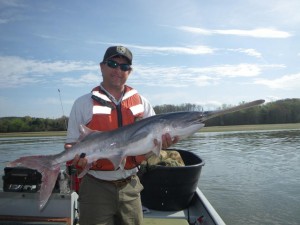 |
| Dr. Michael Gangloff, Aquatic Conservation Research Lab Coordinator Appalachian State University, Boone, NC Mike Gangloff is an assistant professor of biology at Appalachian State University. He teaches courses in Conservation Biology, Ecology, and Aquatic Biology and his research program is focused on conservation of freshwater fish, mollusk and arthropod populations in the southeastern US. Students in his lab conduct field and molecular lab studies with the goal of answering questions relating to conservation and management of imperiled freshwater species and their habitats. Mike is a native of Long Island, NY but escaped as soon as possible. He received a BS in Environmental Science from SUNY Plattsburg in New York’s Adirondack Mountains in 1994, a MS from Montana State University-Bozeman in 1996 (where he studied the winter ecology of Arctic grayling) and then moved to Auburn, AL for his Ph.D. in Biology (2003) working with freshwater mussels. After helping to create the Auburn University Invertebrate Collection and serving as its collection manager for five years he moved to Appalachian State University in 2008. |
Mark Cantrell, Fish & Wildlife Biologist US Fish & Wildlife Service, Asheville, NC Mark is a fish and wildlife biologist with the U.S. Fish & Wildlife Service at the Asheville Field Office. He reviews federal permits and projects, with a focus on hydroelectric facilities, and endangered species consultations mostly in western North Carolina. Mark earned a B.S. (1986) and M.S. (1989) in Wildlife and Fisheries Science from the University of Tennessee at Knoxville. He has over 20 years of experience in research, management, and administration in various aspects of fish and wildlife conservation with Federal and state agencies in the Southeast. His particular interests are restoration of river ecosystems and in conservation of endangered species habitats. Mark has worked to study, negotiate, and restore flow (and sediment) regimes at regulated rivers across the Southeast. Mark has been an AFS member since 2000. |
| Secretary/Treasurer | Secretary/Treasurer |
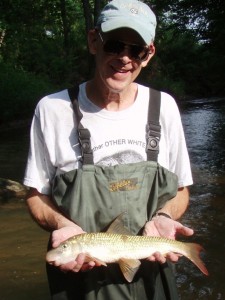 |
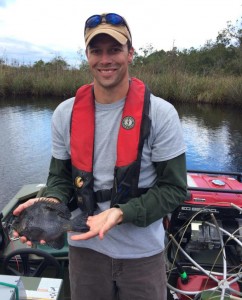 |
| Bryn Tracy, Senior Environmental Specialist NC Division of Water Resources, Raleigh, NC Bryn is a Senior Environmental Specialist with the North Carolina Division of Water Resources, where for the past 19 years he has coordinated the Stream Fish Community Assessment Program. He has worked in the aquatic sciences field in North Carolina for 31 years, has been a Chapter member since 1996, is a frequent contributor to the Chapter’s newsletter, and is a regular presenter at the Chapter’s annual meetings. His interests are in the history, distribution, and protection of the state’s freshwater fish fauna, in the expansion and impact of nonindigenous species, and in the protection of streams and their watersheds where the fish communities (assemblages) are still rated Excellent. |
Tyler Black, Aquatic Wildlife Diversity Biologist NC Wildlife Resources Commission, Creedmoor, NC Tyler Black is the Eastern Region Aquatic Wildlife Diversity Biologist with the North Carolina Wildlife Resources Commission (NCWRC) and has been with NCWRC since 2010. His research focuses on imperiled crayfish, fish, freshwater mussels, and aquatic snails across five river basins in northeastern North Carolina. Recently, he has been working to assess the status of Chowanoke Crayfish (Orconectes virginensis), a state Special Concern species that is being considered for federal listing under the Endangered Species Act. Tyler received his B.S. degree in Biology and a minor in Wildlife and Fisheries Science from The Pennsylvania State University in 2004, a M.S. degree in Biology from Tennessee Technological University (TTU) in 2007, and a Ph.D. in Environmental Sciences from TTU in 2011. He has been an AFS member since 2005, a member of two state chapters, and the recipient of the W. Don Baker Memorial Best Professional Paper Award in 2011. In his free time, Tyler enjoys backpacking, fly fishing, and hunting with family and friends. |
CLICK HERE TO ACCESS THE 2015 NCAFS BALLOT (closed)
For those chapter members who vote, your name will be entered in a drawing for a 2014 AFS Parent Society membership (a value of $80).
Submitted by Greg Cope, Nominations Committee Chair
Update from the North Carolina Division of Water Resources
Wadeable Stream Fish Community Monitoring Program
Fish community data from wadeable Sand Hills streams have been collected by Division staff since 1990 following existing standard operating procedures. However, metrics and biocriteria were never developed specifically for these unique assemblages which have naturally low species diversity and low biological productivity. Fish assemblages were not rated accurately and consequently, the streams were classified as Not Rated until metrics and biocriteria could be developed. Finally, after much blood, sweat, and tears, innumerable versions, and internal and external reviews, a method has been approved!
A 7-Metric Sand Hills Index of Biotic Integrity (IBI) was able to identify impairment and to statistically differentiate between highly impacted sites (rated Poor or Fair) and reference and near-reference sites (rated Good or Excellent). Relationships between the seven metrics versus specific conductance, pH, total habitat score, landuse types, and landuse disturbance classes were also evaluated. The metrics and biocriteria were further validated with additional reference and degraded sites data collected in 2013 and 2014.
Based upon a dataset of more than 90 samples, reference sites and other least impacted fish community sites in the Sand Hills should have low specific conductance, low pH, low abundances of fish, and low percentages of tolerant fish; high percentages of Key Sand Hills Species, Key Sand Hills fish, and Invertivore Cyprinids; at least two Intolerant Species; and high quality instream habitat characteristics. Impacted sites would be expected to have the converse of these characteristics. The Sand Hills NCIBI is now an additional biological monitoring tool that will be used in evaluating wadeable streams, complementing the existing benthic macroinvertebrate assessments.
Examples of Key Sand Hills Species. Photographs by Fritz Rohde, courtesy of the Southeastern Fishes Council.
Submitted by Bryn Tracy, NC Division of Water Resources
Biologists Hope to Restore Rare Fish in Pee Dee River
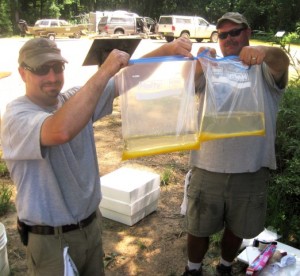
NCWRC McKinney Lake Hatchery staff, Doug Hinshaw (left) and Rick Bradford (right), in April 2014 with freshly fertilized Robust Redhorse eggs from the Pee Dee River. McKinney Lake Hatchery grew out one batch, while a second batch was reared in a SCDNR hatchery.
The Robust Redhorse (Moxostoma robustum), a rare fish that occurs in North Carolina only in the Pee Dee River below the southern-most dam (Blewett Falls Dam) in the drainage, is getting a boost in population, thanks to a partnership between state and federal wildlife agencies, universities, private industry, and the conservation community.
In October, fisheries biologists with the NC Wildlife Resources Commission, SC Department of Natural Resources and Duke Energy, released 13,000 Robust Redhorse, averaging 4 inches (10 cm) in length, into a stretch of the Pee Dee River, just downstream of Blewett Falls Dam in Richmond County. The stocking effort was the latest step in a long-term conservation plan developed by the Robust Redhorse Conservation Committee, which has been leading restoration and research efforts for the imperiled fish since 1995.
Once found in the Catawba, Yadkin, and Pee Dee rivers, Robust Redhorse are large, long-lived fish in the sucker family. They can reach up to 31 inches in length, making them North Carolina’s largest sucker, and weigh up to 18 pounds. Its thick, robust body with rose-colored fins and a fleshy lower lip give the fish its descriptive name. It is listed as State Threatened, making it a priority species for the NC Wildlife Resources Commission’s Wildlife Action Plan, as well as a good indicator of water quality in the Pee Dee River.
Additional information about this project can be found at: http://www.ncwildlife.org/News/NewsArticle/tabid/416/IndexId/9968/Default.aspx.
To learn more about the Nongame and Endangered Wildlife Fund or the NC Wildlife Action Plan, visit the Wildlife Commission’s ‘Conserving’ page.
To learn more about the Robust Redhorse Conservation Committee, its history, and varied resources, visit www.robustredhorse.com.
Adapted from a press release prepared by Jodie Owen, NC Wildlife Resources Commission
Retired but Still Hard at Work!
Lake Norman, an approximately 32,000 acre reservoir on the Catawba River just north of Charlotte, has often been known as a graveyard for fisheries management. For decades, Lake Norman has become the melting pot of species that are not native to the upper Catawba Basin. Through various introductions, by both anglers and biologists, Lake Norman now boasts robust populations of White Perch, Alewife, Blueback Herring, Spotted Bass, and Blue and Flathead Catfish. These introductions have taken their toll on both native and stocked species in the reservoir. The Striped Bass population has been notably diminished by the stocking of Alewife into the reservoir in the late 1990s. Alewife became abundant in the reservoir and began to utilize cooler, hypolimnetic waters that eventually became hypoxic during summer months. Striped Bass soon followed the Alewife to feed and die-offs of Striped Bass became common in Lake Norman during certain summer limnological conditions. NC Wildlife Resources Commission (NCWRC) staff realized that a Striped Bass fishery could no longer exist, let alone thrive, under these conditions.
Due to the popularity of Striped Bass at Lake Norman, NCWRC staff wanted to establish a fishery that would be similar to Striped Bass but withstand the metalimnetic and hypolimnetic oxygen depletion in Lake Norman that routinely occurs during the summer. In 2013, the NCWRC began stocking Hybrid Striped Bass in the hopes of restoring a useable recreational fishery. Hybrid Striped Bass can withstand higher water temperatures and often occupy different habitats than Striped Bass during the summer months.
As biologists we often seek information and data collection in many forms. We often receive correspondence from anglers seeking answers that we don’t have yet. This is frustrating both for the angler and the biologist. I knew the Lake Norman Hybrid Striped Bass fishery would be very high profile and my phone would ring constantly from Striped Bass anglers. Where would I get my information on such a young fishery? Hybrid Striped Bass are often difficult to find at a young age and especially in such a large reservoir.
Why not seek information from people that know the lake well and fish it often? I could think of no one better to ask than Kim Baker, a retired fisheries biologist with 40 years’ experience working on Lake Norman fisheries and a local resident. After talking with Kim, I realized he has fished the lake so often and for so long that I had found a goldmine of knowledge. Kim began collecting fish every month so that we could establish their growth and condition throughout the year. Kim would collect fish through his own efforts and from friends. He would take fish back to his house and record date of capture, capture location, length, weight, and remove their otoliths for aging by NCWRC staff. Over the past year, as Kim has traveled by my house to see his mom in Four Oaks, he would stop along the interstate and drop off any otoliths he had in his possession. To date, Kim has processed approximately 210 Hybrid Striped Bass for the study.
Over the past year, Kim has gone above and beyond in helping a young biologist learn about a lake and fishery that he had very limited information on. Kim and I have learned that Hybrid Striped Bass seem to be thriving in Lake Norman. Hopefully that trend will continue as it gains popularity with anglers. During Thanksgiving week of this year, Kim took me out on the lake for a couple of days and he talked about where I should sample and taught me valuable information about the lake and the fisheries at Lake Norman.
I previously knew Kim, as a fellow biologist, through various past projects with Duke Energy, and seeing him at NCAFS meetings over the years. This project has taught me a lot about Kim. He is a dedicated biologist even in retirement, highly motivated, a great fisherman, and now a good friend. Thanks Kim for all your hard work at Lake Norman – from me and the North Carolina Wildlife Resources Commission! Now all I need to find are more retired fish biologists that live at my other reservoirs. That may not be so easy.
Submitted by Corey Oakley, NC Wildlife Resources Commission
NC State University Student Fisheries Society Update
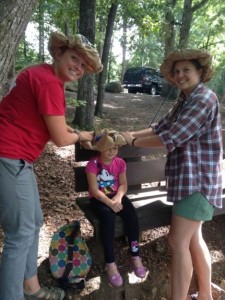
NCSU Student Fisheries Society members assisted with numerous outreach events during 2014, including Fish-For-Fun and Shad-in-the-Classroom events. Pictured left-to-right are Kelsey Lincoln and Ani Popp.
Do you know what television show featured Blinky the One-Eyed Fish? Do you know the difference between a placoid and ganoid scale? Can you identify a Spotted Bass (Micropterus punctulatus)? Members of the North Carolina State University Student Fisheries Society (NCSU SFS) demonstrated their knowledge of these and other topics during the fisheries-themed trivia game that was hosted at the first meeting of the spring 2014 semester.
During each of the eight monthly meetings held this year, the SFS discussed subunit activities, recent events, and chapter news. In addition to fisheries-themed trivia, meetings featured speakers and events to inspire interest in fisheries research. Professionals discussed important water quality and habitat issues threatening local waterways, as well as current research. Through hands-on experience with vouchered specimens, a professional astacologist taught us how to identify crayfish. Brena Jones, the current president of the NCAFS, presented her ‘State of the Fish’ address, which detailed the history of AFS and NCAFS, current issues, and the benefits of being a member, as well as soliciting questions and suggestions from student members. All of our members also had the opportunity to formally introduce themselves through a series of ‘about me’ presentations.
In 2014, we strove to uphold the level of commitment SFS has always shown to our community and remained willing and ready to take on new outreach events. We participated in two events aimed at introducing children, many from the inner-city, to the pleasures of fishing. SFS staffed an educational booth at the grand opening event of Field and Stream, and engaged store patrons in a friendly and knowledgeable manner. Two days were spent removing trash from Rocky Branch Creek, our adopted stream that flows through campus. Additionally, we participated in the ‘NC Big Sweep,’ cleaning litter from Umstead State Park.
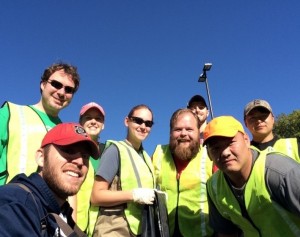
During 2014, NCSU Student Fisheries Society members attended the NC Big Sweep and also assisted with a stream clean-up on Rocky Branch Creek. Pictured left-to-right are Jianchuang Pu, Wilson Xiong, Jeremy Wooster, Alex Zachmann, Tiffany Penland, Emilee Wooster, Gus Engman, and Tomas Ivasauskas.
When SFS was contracted by the Country Club of the Carolinas to reduce Chain Pickerel populations in their community fishing lake (Watson Lake in Moore County), members gained experience using boat electrofishing and interacting professionally with the public. Although many of us are skeptical about the long-term ecological effects of this removal, country club residents were delighted to see that management actions were being taken on their lake. Furthermore, it provided an opportunity to educate curious residents about the lake’s fish assemblage and ecology. The gracious donation made in exchange for our services will be used to fund club activities.
In collaboration with the NC Museum of Natural Sciences’ Shad-in-the-Classroom program, we conducted dissection-based comparative anatomy labs with seven classes at five schools. Fish used in these dissections were those removed from the (aforementioned) community fishing lake. We really enjoyed assisting with this educational program and hope to continue to do so in future years. During a dissection lesson at Broughton High School in Raleigh, a class of juniors and seniors dissected 12 fish belonging to two species; despite the shrieks of horror when the slimy specimens were presented and several subsequent fish beheadings, all 20 students gained an understanding of the internal and external anatomy of fish and learned to appreciate the adaptations that make fish interesting!
Another important part of the SFS experience is attending conferences and disseminating the results of our members’ research. During this past year, our members prepared and delivered over 20 oral presentations and posters. We attended and presented at a number of official conferences, including the Annual Meeting of the AFS (Quebec, Canada), the Spring Meeting of the SDAFS (Charleston, SC), the 25th Annual Meeting of NCAFS (Durham, NC), and the 40th Annual Meeting of the Southeastern Fishes Council (Asheville, NC). Members were actively engaged in the conservation and recovery of endangered species: we shared and discussed research with the Robust Redhorse Conservation Committee and the Sicklefin Redhorse Species Status Assessment. We also presented our research directly to stakeholders, at Trout Unlimited and Musky Angler Club meetings. Many of our members received funding for travel from grants offered through our club, NCAFS, SDAFS, and the Parent Society; we are very grateful for the generosity of individuals and organizations that make such support available.
We are looking forward to 2015! The incoming executive committee is excited about carrying on SFS’s tradition of excellence and making the club even better. We have scheduled a fish identification workshop with two of the Triangle’s best fish taxonomists (Gabriela Hogue and Bryn Tracy), and we are working on a collaboration with Duke University’s fisheries club to host author Paul Greenburg, the author of bestseller Four Fish and American Catch. Because we understand the importance of public education and outreach, we established an ad-hoc committee that will go into effect in 2015 and will be devoted to actively seeking out such opportunities. Meetings are held the second Tuesday of every month at NCSU at 6 p.m. in Clark Laboratory Building; if you are in the area, please feel free to stop by and learn about what we are up to!
Submitted by Tomas J. Ivasauskas, NCSU SFS Co-President
Hydrilla in the Cape Fear River
As most of you know, each year brings with it another new Hydrilla report, yikes. I guess this is the one for this year.
The first report came to me early in September, 2014. Jimmy Dodson, Regional Biologist for NC Parks, observed “hundreds of fragmented pieces floating downstream per minute” in the Cape Fear at Raven Rock State Park. Soon after Jimmy’s report, Justin Nawrocki, Aquatic Weed Scientist at NCSU, responded to the sighting. He confirmed presence of Hydrilla and provided this report:
“I went out paddling today and started from Jordan Lake Dam and went down to the [NC Highway] 42 boat ramp. I didn’t see any growing plants or floating fragments the entire stretch. We then drove down past Buckhorn Dam and just walking around the banks and quickly discovered rooted growing plants. The growth probably extends quite a bit down past this point but I would guess this is where the fragments are coming from.”
Today (September 22, 2014), another bit of information came to me, and some photos. The following is from Bryn Tracy:
“Is this Hydrilla? Found/observed in the Cape Fear River and at the mouth of Campbells (Camels) Creek (35.4763494, – 78.9240737) in Raven Rock State Park, Harnett County, 20 September 2014. I also observed chunks of it floating down the river.”
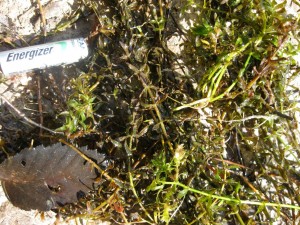 |
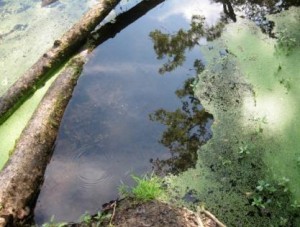 |
Submitted by Rob Emens, Environmental Specialist, NC Division of Water Resources
A Summary of the 2010 Reevaluation of Status Listings for Jeopardized Freshwater Fishes in North Carolina
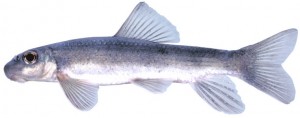
Bigeye Jumprock, Scartomyzon (Moxostoma) ariommum, State Threatened
Photograph by Noel Burkhead and Robert Jenkins, courtesy of the Virginia Department of Game and Inland Fisheries and the Southeastern Fishes Council.
The 15-member North Carolina Wildlife Resources Commission’s (NCWRC) Scientific Council of Fishes convened one early Saturday morning on January 10, 2009 at NCWRC’s headquarters on NC State University’s (NCSU) Centennial Campus to update the 2006 status listings of North Carolina’s freshwater fish fauna. During a day-long meeting and over the course of several months interspersed with a flurry of e-mails exchanged among members, a “final” report was issued in September 2009. Another “final” report was issued in November 2009. After collecting additional distributional data and supporting information on several key species, a “final final” report was completed for delivery to the NCWRC’s Nongame Advisory Committee on November 30, 2010.
As a member of the Council and of the Chapter, I thought that after everyone’s diligent work, the document should “see the light of day’ rather than just reside in a four drawer filing cabinet or on a hard drive somewhere on Centennial Campus. I also remembered that Article 1 (b) of the bylaws of the North Carolina Chapter of the American Fisheries Society state: “ . . .to encourage exchange of information among Chapter members and with the general public” (http://nc.fisheries.org/who-we-are/). Knowing firsthand how much of a challenge it is to keep a newsletter “fed” and published on schedule, I took it upon myself, with the help of Council members, to re-work the imperiled species support summaries and share this information with Chapter members via the Chapter’s newsletter. The Councils’ overall recommendations were re-printed in the June 2010 newsletter with species summaries appearing in all subsequent newsletters, except one (http://nc.fisheries.org/newsletters/). This 17-part series concluded with the Fall 2014 issue (http://nc.fisheries.org/wp-content/uploads/2014/10/Fall-2014-newsletter.pdf).
Upon completion of the project and discussing future options with the Chapter’s Newsletter Committee, a decision was made to compile the entire series into one document and post it on the Chapter’s webpage (http://nc.fisheries.org/wp-content/uploads/2014/12/Summary-Document.Final_.pdf). The series is re-printed with some very minor changes and edits: 1) a map was added for each species; 2) the Literature Cited and Recommended Readings section and contributing authors’ and photographers’ names were standardized; 3) punctuation, spelling, and publication year errors were corrected; and 4) photographs were standardized to 6.5 inches wide. What follows in the document is the 2010 report including supporting tables, followed by the Council’s recommendations, and the species summaries with each page’s header showing the original date of publication. An Addendum has been inserted at the end of document.
I hope all NC AFS Members have benefitted from reading this series as much as I have in writing it. I want to extend a special thanks to contributing co-authors Steve Fraley, Ryan Heise, Brena Jones, Fritz Rohde, and Wayne Starnes; to Fred Harris for supporting this project; and to Kim Baker, Dave Coughlan, Kevin Hining, Brena Jones, Ben Ricks, and Kim Sparks for their constructive reviews and for keeping the Chapter’s outstanding newsletter on schedule and well-fed.
Submitted by Bryn Tracy, NC Division of Water Resources
Native Brook Trout License Plate Offered to North Carolina Drivers
Brook Trout (Salvelinus fontinalis) is the only native coldwater trout in North Carolina. These trout generally exist in cold, clean mountain streams above 1,500 feet in elevation; however, most populations of wild Brook Trout are in streams over 3,000 feet in elevation.
In 2013, the General Assembly authorized the creation of a special license plate to promote the native Brook Trout. All proceeds from the sale of this plate will be used to fund public access to and habitat protection of Brook Trout waters in the state. (The final design will be very similar to the prototype pictured.)
The NC Wildlife Resources Commission’s (NCWRC) 2013 North Carolina Trout Resources Management Plan identified increasing public access and habitat protection as two primary program focus areas. The funds generated from the sale of this special license plate will support projects to pursue permanent easements or property acquisition to conserve Brook Trout and provide angling access. Funds also may be used to remove or replace stream barriers to improve Brook Trout passage, stabilize stream banks to limit sedimentation and limit the effects of acid deposition in high-elevation streams.
Mountain trout fishing is an important component of North Carolina’s economy. Based on a 2009 report, North Carolina had 92,789 mountain trout anglers who had a total economic output of $174 million. Habitat improvement and protection will also benefit the entire stream community, upon which Brook Trout depend.
Download application to apply for the Native Brook Trout License Plate
A minimum of 500 paid applications must be received by the NCWRC prior to July 1, 2015 for this plate to be produced. A link can also be found on the front page of this website.
100% of all proceeds will be used for Brook Trout habitat and fishing access.
Adapted from a press release prepared by Jodie Owen, NC Wildlife Resources Commission
Fred Harris Receives Prestigious Award
Fred Harris, former interim Executive Director of the NC Wildlife Resources Commission (NCWRC), recently received the Clarence W. Watson Award in recognition for his contributions and service to fish and wildlife conservation in North Carolina.
Harris received the 2014 Clarence W. Watson Award at the Southeastern Association of Fish and Wildlife Agencies’ annual meeting in Destin, Fla., in October. The award is the association’s most prestigious honor, recognizing the career individual who has made the greatest contribution to wildlife or fish conservation in areas of wildlife management, fisheries management, research, law enforcement, administration, or information and education. SEAFWA presented Harris the award jointly with the Southern Division of the America Fisheries Society and the Southeastern Section of the Wildlife Society.
Harris, of Fuquay-Varina, worked for the NCWRC for 36 years before retiring in 2008. He began his career with the agency in 1972 as a district fisheries biologist, working his way up through the ranks to become chief of the Division of Inland Fisheries in 1986. Because of his reputation and skills as a leader in conservation, Harris was promoted to Assistant Director of the Commission in 2004 and Interim Executive Director in 2007, where he focused on integrating wildlife diversity, climate change effects, and priority habitat conservation into daily fish and wildlife management decisions.
Throughout his career, Harris has advocated aquatic resource conservation. He directed and supported projects that promoted the wise stewardship of fisheries and aquatic resources and projects that were based on good science.
“Fred always demanded good science from his biologists and he encouraged staff to present and publish conceptual papers that stimulate critical thinking and expand the boundaries of fish and wildlife science,” said Bob Curry, chief of the Division of Inland Fisheries, who, along with Dr. David Cobb, chief of the Division of Wildlife Management, nominated Harris for the award. “Fred has the ability to quietly size up a problem or issue, identify potential solutions and then set about working tirelessly to bring resolution to a situation.”
“On any given day, Fred was known best for picking up the phone, calling his staff members for their opinions, and more times than not, implementing solutions that include the recommendations of his staff.”
While his accomplishments in the conservation field are many, it is his leadership style for which Harris is best known. Harris is recognized in conservation circles throughout the nation as a leader committed to ensuring the use of good science and professional development to empower staff and motivate employees to perform at maximum capacity.
“It would be difficult to find anyone in a natural resource management agency who has coached and inspired more upcoming resource managers than has Fred Harris,” Cobb said. “Fred’s reputation as a life-long leader and an innovator in state, regional, national and international resource conservation is known far and wide.”
A Certified Fisheries Scientist, Harris is a past President and a life member of the American Fisheries Society, the world’s oldest and largest organization dedicated to strengthening the fisheries profession, advancing fisheries science, and conserving fisheries resources. He received the AFS Southern Division’s Outstanding Achievement Award in 1992, the AFS Distinguished Service Award in 1998, and the NCAFS Distinguished Service Award (2004). The NCAFS award for distinguished service by non-Chapter members is named for Fred.
Submitted by Bob Curry, NC Wildlife Resources Commission
Biologists Find Gill Lice in Brook Trout in Cullasaja River Tributaries
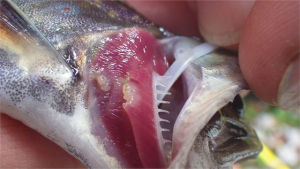
Gill lice attach to a fish’s gills, which can traumatize gills and inhibit the fish’s ability to breathe. Photo by Amanda Bushon.
Fisheries biologists with the NC Wildlife Resources Commission (NCWRC) are asking for anglers’ assistance after gill lice were found on Brook Trout in several headwater streams of the Cullasaja River in Macon County. Staff with the Land Trust for the Little Tennessee found the gill lice in September while sampling fish with the NCWRC near Highlands. The discovery marked the first time that gill lice have been documented in North Carolina waters. Biologists are concerned what affect these tiny, white crustaceans – also known as copepods – could have on native Brook Trout populations. As their name implies, gill lice attach to a fish’s gills. While most fish are able to tolerate a moderate infestation of gill lice, if they’re suffering from other stressors, such as drought and high water temperatures, fish kills and population impacts are more likely to occur.
“We really do not know how widely distributed gill lice are or the ultimate impacts they may have on our native Brook Trout populations,” said Jacob Rash, the NCWRC’s coldwater research coordinator. “We are particularly concerned about those populations in areas where water quality is marginal or non-native species have been introduced and are competing for resources.”
More information can be found at: http://www.ncwildlife.org/News/NewsArticle/tabid/416/IndexID/9976/Default.aspx
Adapted from a press release prepared by Jodie Owen, NC Wildlife Resources Commission
Highlighted Meetings of Interest
2015 NCAFS Annual Meeting- February 24-25, 2014, Carolina Beach, NC. http://nc.fisheries.org/2015-ncafs-meeting/
2015 NC State University Student Fisheries Society- First Tuesday of each month, Raleigh, NC. http://clubs.ncsu.edu/sfs/
2015 Southern Division American Fisheries Society Meeting- January 28-February 1, Savannah, GA. http://sdafs.org/meeting2015/
2015 Freshwater Mollusks Conservation Society- March 22-27, St. Charles, Mo. http://molluskconservation.org/2015Symposium/2015_FMCS-Symposium.html
2015 Southeastern Association of Fish and Wildlife Agencies- November 1-4, Asheville, NC. http://www.seafwa.org/index.php
Valuable Links
The American Fisheries Society Home Page offers a wealth of links to assist you in your fishy endeavors. Information on ordering AFS books, public outreach, annual meetings, chapter links and joining the AFS can be found there.
This and archived NCAFS newsletters, along with a links, chapter information, and upcoming meetings, can be found on our own website.


